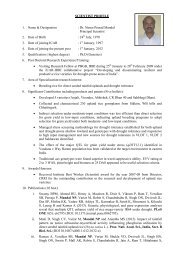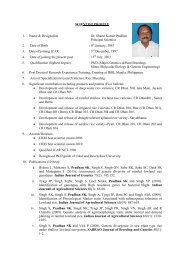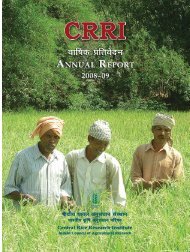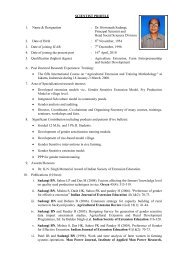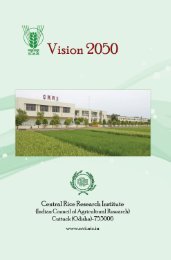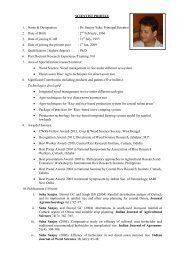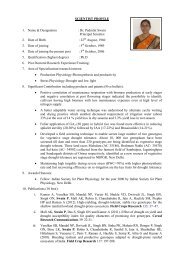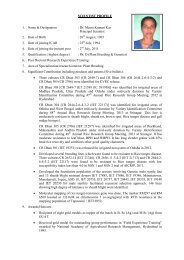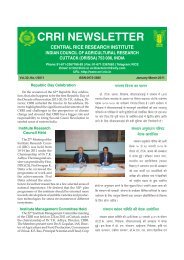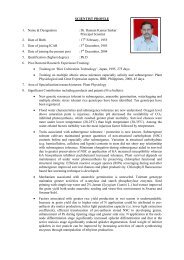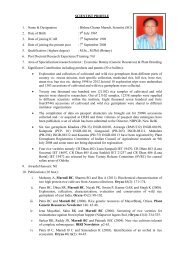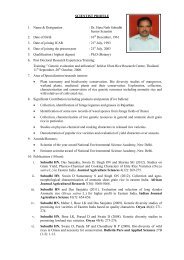Central Rice Research Institute Annual report...2011-12
Central Rice Research Institute Annual report...2011-12
Central Rice Research Institute Annual report...2011-12
Create successful ePaper yourself
Turn your PDF publications into a flip-book with our unique Google optimized e-Paper software.
Developing IPM Technologies for Different <strong>Rice</strong> Ecologies<br />
Table 38. Population of the paddy moth collected in different traps<br />
Date Trap 1 Trap 2 Trap 3 Trap 4 Trap 5 Trap 6 Trap 7 Total Catch*<br />
07/08/2011 136 102 76 93 107 1<strong>12</strong> 84 710<br />
08/08/2011 <strong>12</strong>1 97 71 87 99 103 77 655<br />
09/08/2011 113 88 66 82 87 95 71 602<br />
10/08/2011 102 71 63 76 81 84 69 546<br />
11/08/2011 86 63 57 69 76 76 63 490<br />
14/08/2011 73 56 51 61 67 61 52 421<br />
15/08/2011 67 48 43 57 61 57 47 380<br />
16/08/2011 61 32 37 48 56 48 43 325<br />
17/08/2011 49 24 31 42 43 41 39 269<br />
18/08/2011 43 19 31 37 37 39 33 239<br />
21/08/2011 37 16 24 31 29 33 28 198<br />
22/08/2011 34 16 19 24 23 27 24 167<br />
23/08/2011 29 13 16 21 19 22 19 139<br />
24/08/2011 21 09 11 18 13 17 13 102<br />
25/08/2011 13 03 07 10 09 09 07 58<br />
27/08/2011 09 01 03 03 02 03 04 25<br />
Total catch ** 993 658 604 759 809 827 673 5306<br />
*- Date-wise total catch, **-Trap-wise total catch<br />
Eight botanical oils viz., Til (Sesamum indicum L.),<br />
Karanja (Pongamia glabra Vent.), Bael (Aegle marmelos<br />
Corr.), Castor (Ricinus communis L.), Citronella<br />
(Cymbopogon citratus DC. Stapf.), Crown oil (resin of<br />
Shorea robusta Roth.), Mustard (Brassica campestris L.)<br />
and Groundnut (Arachys hypogea L.) were extracted using<br />
Clevenger oil extraction apparatus and tested<br />
against paddy moth, Sitotroga cerealella under controlled<br />
conditions on variety Ratna. The oil of citronella and<br />
crown oil could effectively protect the stored paddy from<br />
this pest for six months (Table 39).<br />
Management of root-knot nematode using<br />
botanicals<br />
Leaves of 50 plants were tested against rice rootknot<br />
nematode @ 5 and 10 t ha -1 . These were incorporated in<br />
to soil in pot culture experiment. Number of galls per<br />
gram of root was counted to compute the gall index.<br />
Based on the gall index the plants were categorized to<br />
highly effective, effective and ineffective. Argimone<br />
mexicana L., Calotropis procera Aitan, Tamarindus indica<br />
L. and Strychnos nux vomica L. were found to be highly<br />
effective. In the nematode infected fields fresh leaves of<br />
Table 39. Evaluation of botanical oils against paddy moth Sitotroga cerealella<br />
Moth population Moth population Moth population<br />
Treatment 45 DAR 90 DAR 180 DAR<br />
Til 169.5 (13.03) 710 (27.75) 2010 (44.83)<br />
Karanja 54.50 (07.41) 240 (15.50) 650 (25.50)<br />
Bael 79.50 (08.94) 326 (18.06) 870 (29.50)<br />
Castor 110.5 (10.51) 450 (21.22) 1170 (34.21)<br />
Citronella 20.50 (04.58) 93 (09.66) 201 (14.19)<br />
Crown 22.00 (04.74) 110 (10.51) 316 (17.79)<br />
Groundnut 163.50 (<strong>12</strong>.78) 723 (26.89) 1650 (40.62)<br />
Mustard 160.50 (<strong>12</strong>.64) 650 (25.50) 1390 (37.28)<br />
Control 220 (14.84) 880 (29.67) 2800 (52.91)<br />
SD at 5% 4.67 7.98 11.73<br />
DAR= days after release; Initial grain moisture-16%<br />
Data in parenthesis are “X+0.5 transformation of original value<br />
Dose @ 0.5%v/w; Initial release 5 pairs of moths<br />
CRRI ANNUAL REPORT 2011-<strong>12</strong><br />
87



